Dear friends,
Stay tuned for reports, live updates, and photos…
Mertov’s Tennis Desk is once again on site at Wimbledon.
Note: Follow Mertov’s Tennis Desk on Twitter for live updates throughout Wimbledon.
Dear friends,
Stay tuned for reports, live updates, and photos…
Mertov’s Tennis Desk is once again on site at Wimbledon.
Note: Follow Mertov’s Tennis Desk on Twitter for live updates throughout Wimbledon.
Interview done on May 27, 2015, at Roland Garros, following Diego’s loss to Gaël Monfils in the second round of the French Open. Score: 4-6 6-4 4-6 6-2 6-3
This was a one-on-one interview I did with Diego Schwartzman at the French Open, initially for Tenis Dunyasi magazine, the largest monthly tennis publication in Turkey. This is the English version of the interview (which was also its original version). One month earlier, Diego reached the semifinals in the Istanbul Open, his highest achievement at the professional level for the 22-year-old Argentine. He earned a ranking of 57 on the Monday (May 4, 2015) following the Istanbul event, and to this day, it remains his highest ranking. Currently, he stands at number 65.
Diego gracefully accepted to do a one-on-one interview despite having lost a heartbreaker and I cannot stress enough how delightful and modest he is as a person. I have already had the chance to observe him live at the Istanbul Open earlier in the summer. He handled his progress to the semifinal round, and his loss to the eventual winner Roger Federer, with class and sincerity. As if his character needed a confirmation, as I was waiting for him to come, few South American journalists, especially one from Argentina, could not praise him enough to me, telling me what a “nice guy” Schwartzman was and that I would enjoy my interview with him. They were completely right. When I told Diego about this right before we began chatting and mentioned his high reputation among the South American media, he extended a genuine smile and nodded his head with modesty.
About today’s match… In the 4th set Gaël started getting more aggressive compared to the first three sets and it worked for him. Then, in the beginning of the fifth set, you also started well and leveled back the match. He began to pump the crowd up, and you joined in as well, began showing your fist and celebrating the points won with animated passion. However, do you think it would it would have been better to stay calm against someone like Monfils at that point of the match and not join the “pump-fist” parade, because it only motivated the crowd to get even more behind Gaël, further energizing him?
Diego:
I understand what you say. But I was also playing the first three sets aggressive, focused, solid, motivated. I remember in the fourth set, it was 2-2, I had two break points to go up 3-2, and he hit two aces in the break points. Then he felt well, and he broke me immediately after. He started to play with the groove. It’s good for him, not so good for me. In the fifth set, I played well again and had chances in the first games, but again he played well, broke my serve, and served amazing after that. I am not so sure if the motivation from the body language was really the big factor. He served very well in the fifth set.
Few weeks ago, you did very well in the Istanbul Open, reaching the semi-final round of an ATP event, for the first time in your career. You had one year with great success in the past, then last year you had an excellent year in the Challenger circuit. Now, you reach higher in ATP events and to Monfils in 5 sets in the 2nd round of a Major. Now that you are reaching for the next level in the pro circuit, do you sense that Istanbul Open was a big step, a turning point for you, and your confidence?
Diego:
Yes! Istanbul was amazing for everything. I played very well against good players like Jurgen Melzer, Santiago Giraldo.. I played very well in all the matches there [Schwartzman lost to the eventual winner Roger Federer 6-4 in the third set, in the semifinals]. Then I go to Rome and also brought that good feeling there. Then, I came here and played well again the first round. And now I just played a 5-set match against Monfils. I feel really well. I need to be focused on my tennis, training, work with my team the same way. I need to be a “regular” during the whole year and improve my tennis continuously. I need to go step by step.
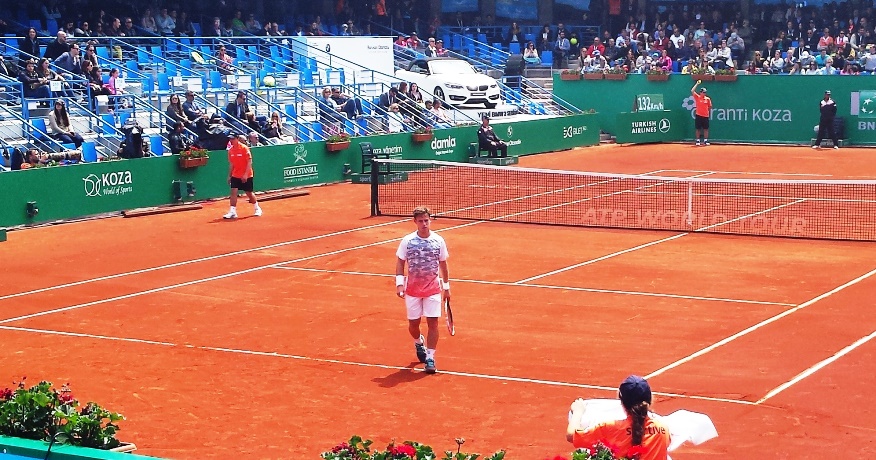 Schwartzman in his second round win over Giraldo at the Istanbul Open
Schwartzman in his second round win over Giraldo at the Istanbul Open
You just had an injury.
Diego: Yes in Rome.
But it was not a major injury.
Diego: No, it was an extension, 2 mm here (points to the inside of his upper leg), I can’t play in Nice so I pulled out. I came directly here, I felt well all the time. It’s ok.
Have you ever had big injuries in the past?
Diego: No, never, that was actually my first injury.
Question about your tennis game… What is your next goal now? I am asking this in the context of your game. You hit every shot in the book, you hit spin and slice, you hit drop shots and angles, you come to the net, you hit kick or slice serves, as well as a hard first one. So what next would you like to technically improve in your game?
Diego: I need to improve my second serve. My first serve is good I think. Then I need to improve all in my tennis, physically and mentally. My I need to improve my forehand, backhand, and all the other things, because now the players are so good. I don’t have many chances in the match so I need to improve for the few chances that come, I need to be fully focused at that moment and really want to seize that chance.
When you practice in the off-season, do you focus on one particular thing to improve or do you focus on everything?
Diego: No, no, many things many things. The serve, the forehand, you can improve a lot in many things.
You have a big family, two brothers and one sister. Does your family show interest in tennis, or do they love tennis through you? Do they really know the game?
Diego: Yes they show interest. They know about me, and therefore now, they know even more about tennis.
So you are the only one in your family to play competitive tennis?
Diego: Yes, my father and mother play tennis but only amateur tennis in the club on weekends, not professional like me. They are very good models for parents. They support me in every way.
Stan the “Iron” Man
When Stan Wawrinka hit his 60th winner (yes, that’s right, double the number of his opponent’s) on Sunday to triumph over Novak Djokovic, he finished 5 weeks of straight ATP events on very high note. Nowadays, you rarely come across a top player who plays one of those the week before a Major, let alone end up winning the Major. For example, when Brad Gilbert became Andy Roddick’s coach, one of his first rules was not to let Andy play in an event prior to the Majors. Andy did previously do just that, before 2013 French Open. Although he won the St. Poelten event, it did not serve him well as he lost first round in Paris. The last two players to accomplish Wawrinka’s feat were Lleyton Hewitt and Thomas Johansson, both in 2002. I should remind that Patrick Rafter played a whopping seven weeks straight in 1998, leading into the US Open that he won. He also won three of the five events before, two of those wins coming in the Masters 1000 events (called Masters Series back then) in Toronto and Cincinnati. Although Wawrinka only played two matches in each Madrid and Geneva, his vctory still put into question one of the taboos in high-level play, the refusal to play the week preceding a Major.
Tennis: Part of the Parisian Bar scene
Watching sports in bars is an established activity in the American life. Yes, Europeans do it too, especially for football (ok, fellow Americans, I mean soccer), but the term Sports Bars is a common theme in the U.S. and the idea of watching a sports event in a bar often supersedes the choice of doing the same thing in the comfort of your home. One thing is for certain: tennis is not included in this activity. College Bowl games, NBA playoffs, the Super Bowl, the Stanley Cup, yes, but heavens forbid if a bar were to announce having a tennis match on TV, and still expect a big crowd. This is not the case in Paris. Throughout the two weeks, you can see tennis regularly on the TV screens in bars. People watch it, discuss it, argue about the players, and comment on points. Below is a scene from a bar on the 16e arrondissement, on a week-day afternoon.
And yes, they even advertise the fact that Roland Garros will be shown on the screens of the establishment, although this particular bar on 18e arrondissement seems to have forgotten how to spell France’s sacred tennis arena, on the day of the men’s final.
Crowds and Circulation, Never-ending Headache
I know I have harped on this endlessly in the past and in my earlier post during this tournament, so I will try to keep it short this time. Roland Garros organizers got a big boost from the government who declared that they are behind the new project for the expansion and modernization of the site. Tournament director Gilbert Ysern proudly announced that the permits are on their way, although he faced more urgent matters during the two-week run, such as the metal panel on a scoreboard collapsing on spectators. Yet, the projected completion date is now 2019. It was in 2011 that Roland Garros won the vote to keep the tournament at its current site, and the authorities have been promising the modernization ever since. During the campaign for the vote, 2016 or 2017 were the projected finish dates. Following struggles with the ecologists and various organs of the government questioning the expansion, the turtle-slow French bureaucracy showed its teeth and delayed its commencement.
Nevertheless, it is still the only Major that does not possess a covered court or lights. The other three Majors are not only far ahead of the French Open in terms of space (the US Open and the Australian Open are more than three times the size of Roland Garros), but they have also gotten busy covering a multitude of courts – each already has covered courts – and have had lights on courts for a long time.
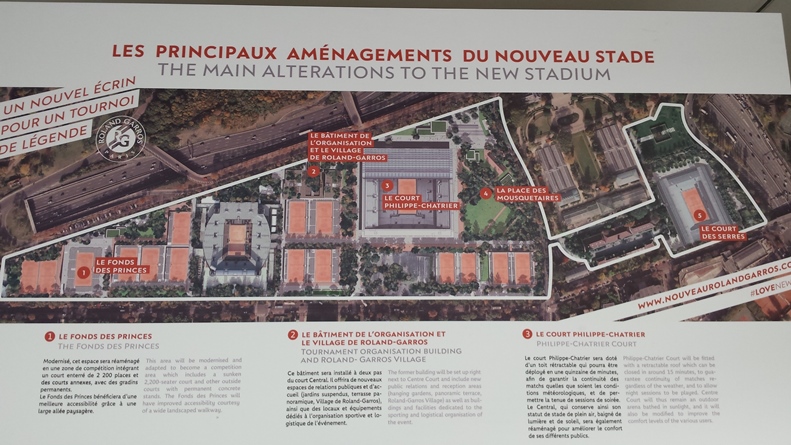
But more importantly, the circulation inside the site is a nightmare for spectators. It is obvious that too many tickets are being sold, leading to lines to get in the outside the courts that make the spectators miss a multitude of games, or even sets, while they wait in line. And entertainment like the one below in the alleys temporarily help distract the stifling effect, but does not suffice.
For example, the two ladies in red that you see below, got in this line when the score was 2-1 in the Anna-Lena Friedsam vs. Alexa Glatch 1st round match. At the time this picture was taken, Friedsam just closed out the first set 6-2.
This was the case for a first round match between two unseeded players, both ranked below the top 100 on that day (Friedsam is 97 in this week’s rankings). I will let you imagine the case for seeded players competing on the outside courts. When it rains, the amount of limited covered space guarantees that many spectators will be left outside in the rain. It often leads to scenes like the one below, under the stadium stands of the two show courts, Philippe Chatrier and Suzanne Lenglen (this one is from Chatrier).
I did say I would try to keep it short, but apparently I failed. I promise to hold myself back the next time this endless issue, unique to Roland Garros among the four Majors, agonizes my mind. Now onto a more pleasant topic…
Roland Garros Musée – A Gem
If you ever get to attend Roland Garros in person, you do have one choice if the crowds stifle you: a visit to the RG Museum. You will not be disappointed. On your way down the stairs to the museum area, you are welcomed by a wall displaying past champions.
Once you are downstairs, the first thing you perceive is the row of rackets from all periods of tennis, stashed on your left.
Once past that, there is the history of tennis with authentic paraphernalia in front of your eyes. If you are an ardent student of the history of tennis, like me, make this visit your priority. This year, there was also an impressive exhibit on the evolution of style and fashion in tennis. Yes, tennis players such as Max Décugis and Hugh Laurence Doherty (wearing the manteau de tennis in the picture) wore items such as the ones below, in the early 20th century.
Here Comes the Grass-Court Season!
Now that the grass-court season has started, with an extra week to enjoy prior to Wimbledon, one of the best calendar-related decisions the people in charge of our game have ever made, our attention turns to a different style of play, different stories to follow. Some players that have been forgotten during the clay-court season may shine through during the next five weeks. My next stop will be the culmination of this period, none other than Wimbledon. In the meantime, I will try to post up more articles (assuming life lets me do it). Until next time!
Coming into today’s final match, the head-to-head record between Serena Williams and Lucie Safarova was 8-0 in the American’s favor, for a very good reason. Williams is very good at forcing her opponents into a defensive position and demand that they produce a high-level, counterpunch-style tennis. Lo and behold, that happens to be exactly what carries Safarova through most of her wins: the ability to set her feet, shift the shoulders forward to produce some penetrating winners from both sides. Let’s simplify the equation: what Serena does very well, single-handedly negates Lucie’s biggest weapon and ruins the core of the Czech’s plan A.
If you have access to the replay of the match, and you want to see the type of damage that Safarova can inflict on her opponents when she gets her feet set, watch the two points from 30-0 to 30-30 at 4-2 in the first set. Another good example is the first point of the 3-1 game in which Lucie struck three good shots in a row, pushed Serena around, and finally won the point. Now, if you want a great contrast to that last example, watch the following point at 15-0. In that long point, Lucie stays in control for several shots but can’t put it away; then Serena counterpunches with her forehand hard to the cross-court corner and puts Lucie on the run. Next (and yes, you guessed it), Lucie misses the very first shot (a backhand) that she has to hit on the stretch from the outside the boundaries of the singles lines. A second example of the same contrast happened also at 5-5 and 15-0 in the second set, with Safarova serving. During the majority of that long point, the ball traveled back and forth at high speed, yet remained mostly within the singles line, which allowed Lucie to hang tough. However, as soon as Serena hit a hard, sharp cross-court shot and pushed Safarova out to the doubles alley, the Czech had to stretch and float the shot back, which then allowed Serena to hit the winner to the open court.
These are only a couple of examples of why Serena had more trouble against Victoria Azarenka, Sloane Stephens, and Timea Bacsinszky. They could counterpunch Serena’s power with accuracy and speed when they were put on the run. Serena still ended up winning because she has superior skills and, this next one is ex-cathedra, she can raise her game when needed. Azarenka can power back Serena’s shot and surprise her, Stephens and Bacsinsky can hit backhands and forehands on the stretch, generating power with the flick of their wrists (especially Bacsinszky on the backhand side). Safarova, on the other hand, is not the speediest player moving side-to-side, which is an oddity considering how exceptional her movement is around the ball, in place, using quick and small steps (reminds me of Andre Agassi).
You are probably saying to yourself “Wait, did you watch the match? Lucie went three sets too!” My response to you would be, don’t let the second set fool you. This match was never out of Serena’s control. Safarova got back in the set only because Williams began to commit double faults and few untimely errors out of nowhere. It also helped Safarova that throughout the comeback in the second set, from 1-4 down to winning the tiebreaker, the Chatrier crowd got behind her (they chanted her name in two different versions: “Lucie” the French version, “Lu-zi-yé” the Czech version!)
Yet, the main plot remained untouched. When Safarova served her only double fault of the match at 2-1, and 30-40, and lost the early break, one could sense that it was the beginning of the end for the Czech. It was confirmed the next time Serena had a break point, two games later, up 3-2. The players engaged in a rally, and the original pattern ensued, with Serena collecting a mistake from Safarova the first time she pushed her to the outside of the court.
There are three types of matches that end lopsided. First case is when both players play the same style, and one does everything a little better than the other (Nadal-Ferrer on clay comes to mind). Second case is when one player’s weakness plays into the strength of the other, or vice-versa. Third is when a player, for one reason or another, decides not to put forth any effort to win (there are plenty examples of this in the past, you pick your own). Today’s case would have fit the second one if it were not for an extended period of meltdown by the American in the middle portion of the match.
Now Serena Williams stands at 20 Major titles, only second to Steffi Graf’s 22. This could also be the year in which she achieves the Grand Slam, the only elite accomplishment that is still not in her résumé. She is 33 years old, but still rules the W.T.A. arena, and there is no reason to think that both accomplishments are not within her reach.
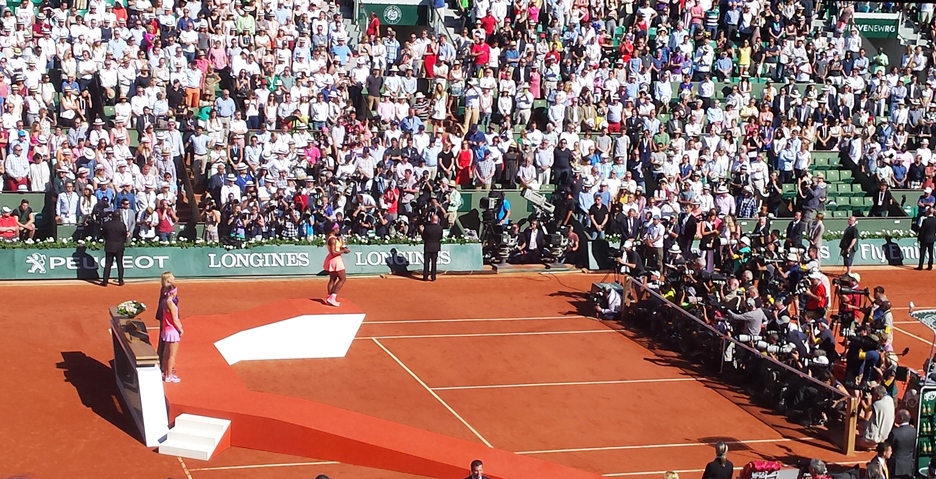
Note: Follow Mertov’s Tennis Desk on Twitter for frequent live updates from Roland Garros
The effectiveness of the first shot behind the first serve is an underrated statistic. First of all, it is extremely hard to keep track of it despite how easy it is to recognize when it occurs. There are many intangibles, not in the execution of the 1-2 punch itself, but on the consideration of which ones belong to the statistics’ count. Do you consider every single shot that is hit after the opponent returns the ball? Do you consider every winner on that shot when, in some of those points, it was really the serve that got the job done and earned a weak return that sat high inside the service line? What about when you hit a big serve and follow it up with even a bigger shot, yet you still end up hitting one or two more shots to finish the point although you clearly gained the advantage thanks to the serve and the next shot (example: Wawrinka serving, 4-5 in the second set, 0-15)? Do you add that to the statistic? Finally, do you give the same consideration to the shot hit behind a great second serve? These are all subjective approaches, and there are many coaches who keep a close eye on this stat depending on their expectations from their player. It is also why you rarely see the main media offer statistics on this shot.
Wawrinka is a unique case in this category due to his approach to the follow-up shot behind the serve. When he is focused and his game is ticking with the precision of a Swiss clock, he smacks the second shot of the rally following his first serve, regardless of his position in the court. If you want to see a good example of what I mean – and I am sure replays of the match will pop-up on various TV channels over the next 48 hours – watch the 40-30 point at 6-3 3-2. You will see Stan serve, and Tsonga make an above-average return that bounces close to the baseline and pushes Stan back. Yet, Stan will still go for the big forehand winner to the deuce corner (while he is backing up, mind you?), and hit the clean winner somehow. Now, this example was an extreme one, although similar points took place a number of times, both against Tsonga in the semis and Federer in the quarters. The more usual case is when the return falls short due to a powerful serve and Wawrinka simply nails the forehand to the open court or behind the opponent who is recovering from the return corner. Two prime examples are the first and the last points of the 6-3 2-1 game.
Of course, for this simple and efficient game plan to work you need a high first-serve percentage and powerful ground strokes, both of which Stan possesses in his arsenal. On a secondary level, it also helps to avoid double faults. Wawrinka did not commit a double fault until the later stages of the second set (he committed none against his third-round opponent Steve Johnson and against Federer in the quarterfinal). In fact, when Tsonga broke Wawrinka’s serve in the eighth game of the second set, that was the first time the Swiss got broken since his match against Gilles Simon, in the round of 16s. Even as Tsonga won the second set, coming up with a solution to Stan’s 1-2 punch still remained a priority. It was Wawrinka who decided to render his 1-2 punch less of a factor in the second set, by hitting only 31% of his first serves in, after 69% in the first set. In other words, one of the two key components (see the first sentence of this paragraph) of an effective 1-2 punch was missing.
In the crucial third set, Tsonga found his top-class serve that helped him win so many matches in big stages. It was not until his fourth serving game that he lost a point on a first serve. The seventh game constituted a minor turning point for Wawrinka. His serve finally came back and carried him through that game precisely when Tsonga was starting to receive a large amount of amour from the French crowd and was giving some of his own right back at them by holding his fists up. Stan knew the importance of that game and pulled two of his most animated “Come on!” yells, the first one coming after an ace served wide to the deuce side at 30-30. The 4-4 game was another crucial one. Stan’s first serve deserted him through the long game in which Tsonga first made a silly return cross-court forehand winner attempt from far outside the court at 0-30, and then, could not capitalize on two break points later in the game. The tiebreaker was inevitable.
In the tiebreaker, Stan stood tall in the string of grinding points from 1-1 to 4-3, and closed the set out by winning the next three points. When he walked to the bench two sets to one down, Tsonga probably understood how Wawrinka felt at the end of the second set and was asking himself “How did I let this set get away?” After all, the Frenchman served very well throughout the set while the Swiss remained below 50%, and had six break points (of which he converted none) while his opponent did not even garner one.
I reckon, there were many tennis fans who predicted during the third set that, considering the scorching heat in Philippe Chatrier court, the loser of that set would perhaps lose his energy, lower his level of tennis, or even fold in the fourth one. Tsonga did not exactly fold, but slowly faded away after he squandered additional break points away at 1-2 down that would have helped him get back on serve. Wawrinka held his serve for the rest of the set and triumphed, after 3 hours and 46 minutes, by the score of 6/3 6/7 7/6 6/4
At the end of the day, the main story of the match was Wawrinka’s ability to serve-and-finish (and no, that does not equate serve-and-volley) in two shots, and Tsonga’s frustrated attempts at countering that crippling disadvantage in order to find some type of equilibrium. Stan was throwing something at Jo and asking him to deal with it. Jo had two options: either deal with it, or find something else to throw back at Stan and balance the “headache” count. He could do neither. The Swiss now finds himself in his second Major final, first Roland Garros one. A big challenge awaits him, but he has shown enough in the past that he is not to be discarded when it comes to big stages in the Majors. Stan’s unique 1-2 punch helped him build his singular résumé that seems to shine during the weeks of Majors and glimmer for a large majority of the other weeks in the ATP calendar.
Note: Follow Mertov’s Tennis Desk on Twitter for frequent live updates from Roland Garros
Roland Garros Girls’ Singles, 2nd Round Match – Tactical analysis
As I strolled into Roland Garros little before the beginning of scheduled matches at 11:00 AM on Tuesday, I knew the main attraction would be later on Philippe Chatrier and Suzanne Lenglen courts where, beginning at 2 PM (or “14 heures” as the French say), two women’s quarterfinal matches would take center stage, followed by two men’s quarterfinals. My plan until then, consisted of engaging in one of my favorite activities at Majors: watching some of tomorrow’s potential stars in the juniors’ matches. One of those featured two girls far beyond their ages in terms of mental maturity and on-court I.Q., and ended up grabbing all my attention. The match in question was on Court 6, between the American Catherine ‘Cici’ Bellis (seeded 4th in the juniors’ draw) and the Russian Sofya Zhuk.
The 16-year old Bellis is not an unknown to most tennis fans. Her claim to fame took place when, as a 15-year old at the 2014 US Open, she defeated Dominika Cibulkova, then-ranked 13 in the world. Sofya Zhuk is a fast-rising Russian teenager. At 15 years old, she is 7 months younger than Cici, and not known for any one noticeable win, although steadily improving (I can say this with confidence. I saw her play 2 years ago and the improvement is monumental). Having watched her match in the previous round, I knew that the 4th seed Bellis would face a monumental challenge. What I did not know is what a fascinating mental battle the match would turn into, and how tough these two teenagers would be under pressure circumstances that would make most adult tennis players crumble.
Do not get me wrong, the quality of tennis did have its low moments. There were untimely double faults, a string of bad games from one player or the other, and a topsy-turvy wind that would not allow the players to gain any decent timing on their strokes. Perhaps it is exactly what made the match-up so intriguing: the possibility to observe two teenagers deal not only with adversity in terms of weather conditions, but also with the fact that they had to overcome bad streaks, missed opportunities, and blown break points, and yet, never lost their sanity through a memorable epic crescendo in the third set. By the time it was over and Bellis, unable to hold her tears of joy, ran up to the net to shake Zhuk’s hand, I knew I had to add yet another write-up to my “tactical analysis” series on this blog, featuring this match. Its story needed to be told, and more people than the 150 or so people that were there needed to know what “went down”.
Bellis broke Zhuk’s serve early to start the match, and eventually led 4-2. Zhuk was aggressive on returns, putting pressure on Bellis from the first shot of the rally forward. On a separate note, it may have worked to some degree at least because it led to seven double faults by the young American, few coming at inopportune times. But it was rather a string of unforced (and a few forced) errors by Bellis from the baseline that resulted in Zhuk winning four games in a row to steal the first set 6-4. Zhuk did her part efficiently, avoiding unforced errors altogether during the four-game streak, other than one double fault (and she was not just “bunting” the ball in either, mind you?). It was such a good run that she even recorded her only two aces of the match during that stretch.

Second set saw the level of tennis drop. Bellis played a great first game, breaking Zhuk immediately to bring her opponent’s four-game winning streak to a halt. She went up 40-15 in her service, only to double fault, miss a makeable passing shot, miss an easy forehand sitter, and make another double fault, to lose four successive points and hand the break right back. To return the favor, Zhuk played one of her worst games at 1-1 and lost her serve again. Bellis finally recorded the first “service hold” of the second set to go up 3-1, after which she trimmed down the number of errors and gained confidence, as Zhuk never recovered. The not-so-memorable set (for both, really) ended 6-1 in Bellis’ favor.
Then, something that we see too often (unfortunately, I dare to add) happened again: the player that lost the set took a bathroom break. “It is in the rules, so why not use it right?” is the argument that one always hears. I guess until a decent answer is found to that question, it will continue. Maybe in the 1980s and 1990s human beings were made differently because I don’t remember ever leaving the court for a bathroom break (except maybe once or twice), and I remember very few others doing so. But it seems in the last ten years or so, somehow bodily needs pop up right when sets are lost. That being said, I don’t want to single out Zhuk here because I did a one-on-one feature interview with her this week and I can affirm that she is a genuinely nice girl, a delightful character. If anything at all, I am inclined to believe that either she really had to go, or simply used the rule to recover mentally from a set during which she never held serve. But anyone who has read my articles before knows that this bathroom break business right when the opponent is on a good streak drives me absolutely crazy. So, allow me a few sentences of digression here. Ok, now, let’s move on.
Zhuk came back on the court, and lo and behold, it was a 180-degree turn in the momentum. The Russian brought back her accuracy in her ground strokes and put Bellis on the run. It was the second streak of the match during which Zhuk was the one dictating the point with Bellis running down as many shots as she can, basically scrambling to stay in the points, and sometimes failing to do so.

Zhuk won the first three games to go up 3-0, while Bellis who sat down and waited during the break, couldn’t buy a shot that went over the net or one that bounced within the singles lines. This is also the streak during which Zhuk garnered a lot of errors from Bellis by steering the ball down-the-line more often than she has done in the first two sets, and catching her opponent on the back foot. The wind also picked up considerably at this point and made both players occasionally hold up before serving due to swirling clay around them. Serving at 3-0 and deuce, Zhuk served a second serve that was called out, one that she believed to have touched the line. A brief argument with the umpire over the mark ensued, enough to keep her thinking about it until the next point which also ended in a double fault (2 of her 5 double faults in the match). Bellis was finally on board in the final set (1-3).
That may be all the push that Bellis needed. She also modified her tactics after she went down 0-3. Instead of trying to out-hit Zhuk who was on a roll at that point, Bellis began to change pace and use more variety. She sliced more than usual, used drop shots, and for the first time, she began to frequently ‘moonball.’ When Zhuk lost the game and her serve at 3-0, these extended points became crucial and they held the key for Bellis to get back on equal terms in the final set. Now, Zhuk had to be more patient, because Bellis, by now, ceased to make early, easy errors in the rallies, as was the case in the first two sets. The Russian needed to either back up behind the baseline to hit those high balls back, or step in and take them on the rise for a more aggressive approach. Both options brought its different set of problems. Backing up meant giving up the ability to dictate the points, which has own Zhuk a lot of points early in the third set, and taking the ball on the rise meant too high a risk due to the wind and the possibility of a bad bounce on clay.
A very long point at 3-1, deuce, exacerbated the problem for Zhuk. Perhaps the longest rally of the match up to that point, Zhuk put Bellis on the run throughout the exchange while Bellis was content to return the ball high and recover to the middle of the court. At one point, Bellis was really stretched to the deep forehand corner and floated the ball high back to the middle of Zhuk’s court. I saw Zhuk take couple of steps in, almost as if she decided to hit a swing volley (which would have been the right choice), but then she backed up and let the ball bounce, giving Bellis time to recover. Bellis ended up winning that point, and you can tell it meant a lot to her as she gave the longest standing fist pump toward her corner up to that point in the match (see picture below)

Another digression: This is what I would tell my players in similar situations all the time, with regard to overheads and high swing volleys: “Step in, take the risk, and miss if you have to, but do it! If you don’t, and you choose to extend the point and end up losing it, it will be worst for you, and it will pump your opponent up. It will reassure them that the pattern is working. Instead, you choose step in, and even if you miss, you know you did the right thing, and they know that you are willing to do it, so they will think twice next time.” Zhuk, in this case, chose to stay back, played into Bellis’ hands, and lost. Bellis, naturally, kept playing the same strategy to win the next game. By now, at 3-3, Bellis was feeling good, and Zhuk was in the middle of a nightmare. Points were long and while Zhuk was searching for answers to tilt the momentum back to her favor, Bellis was constantly hindering her plans with wall-like consistency and no-pace high balls mixed in with the occasional slice or flat hit. Then, came the crucial break point which basically reflected everything that you have just read above. Watch how difficult it has become at this point in the set for Zhuk to deal with different height on balls that vary in pace, and how frustrating it gets for her as she tries harder and harder to end the point or collect an error from Bellis.
Just like that, Bellis broke Zhuk to win her fourth straight game since starting the final set down 0-3. Zhuk goes straight to the umpire (you see her take the first two steps at the end of the clip above) and asks for the trainer, pointing to a spot below her right knee. Now, this is where I believe umpires and “rulekeepers” in general should strive to be more efficient. I timed it, and it took close to 5 minutes for the trainer to come out to the court. Court 6 is not one of the outside courts. It’s located right by the Chatrier court and close to Lenglen court. It should not take five minutes to get someone out there. Time five minutes, wait through it, and you will see how long it actually is). It took another 45 seconds for the trainer to identify the issue which was followed by the three-minute medical time-out. Bellis had to sit and wait around nine minutes after having won 4 games in a row.
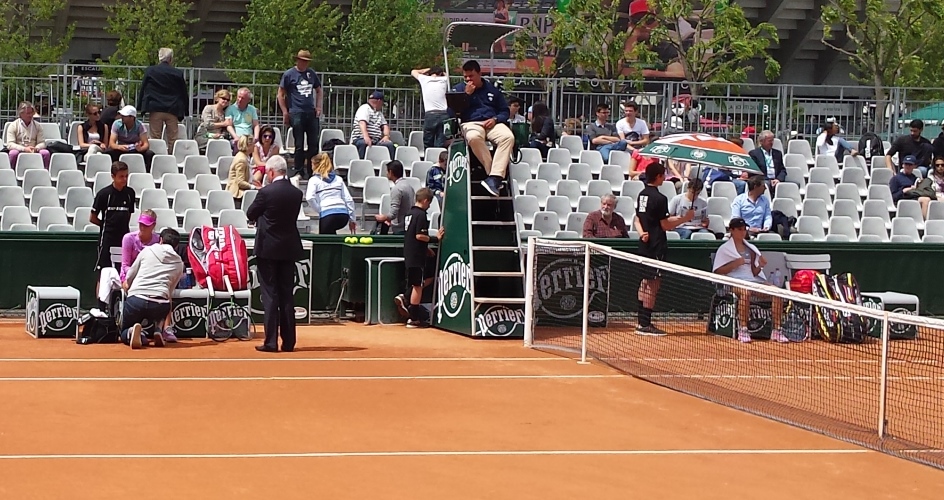
Finally, when the players stepped back on the court, lo and behold (again), Bellis lost four points in a row and the score was 4-4 in the blink of an eye. Three were on unforced errors by Cici, despite the fact that she climbed back from 0-3 to 4-3 precisely by cutting down on errors and frustrating Zhuk with long rallies. Oddly enough, she also stopped the high-ball bonanza that has worked for her in the last 4 games, and went back to duking it out with Zhuk. Perhaps, she felt that her confidence was now back and that she could go toe-to-toe with Zhuk again, even with the pace (if so, she did indeed turn out right).
From that point forward, spectators on Court 6 marveled at two spectacular youngsters, with nerves of steel, who were dealing with the increasingly violent wind, and were attempting to outwit each other. Zhuk remained resilient despite Bellis’ several different tactics. She kept yelling “Come on” to herself (which is, according to her, something she consciously does to keep herself focused) even when she was struggling to find a solution to her opponent’s consistency. Bellis who was focused, but not so vocal through most of the first two sets, was now in full “war mode”. She was posing the questions, Zhuk was answering them. When Zhuk would get the upper hand, Bellis would not panic and pull out another plan from her bag of tactics. Both girls are good athletes who refused to lose, and that led to several games of intense rallies and increasing tension on Court no. 6. Zhuk finally reached a match point on 6-5 in which she missed a forehand long. Bellis won that game to equalize at 6-6. The next game was hotly contested. Zhuk had at least 5 game points (that I counted) and could not capitalize. Bellis, after missing, one herself (maybe two), finally capitalized on this point:
In the 7-6 game, Bellis yet once again came out victorious after Zhuk had more game points to equalize at 7-7. Bellis essentially saved a slew of game points against her in the last three successive games – one being a match point – and capitalized on the few that she had, to come back from 5-6 to win the final set 8-6. How tight was it? The picture below, taken at the moment she won the match should clarify some of it.
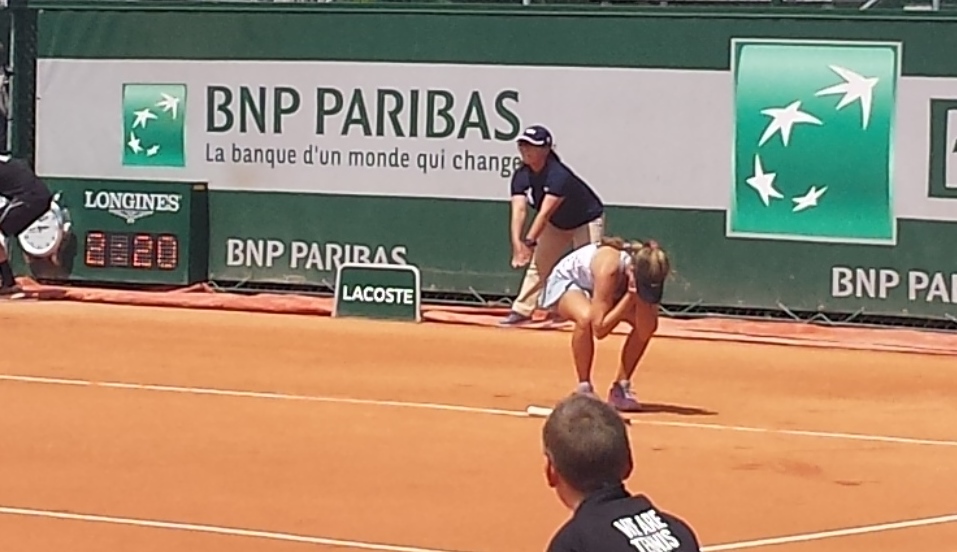
On my tweet, I called it “relief celebration”. She got back up, and walked toward Zhuk to shake her hand, barely holding back tears.
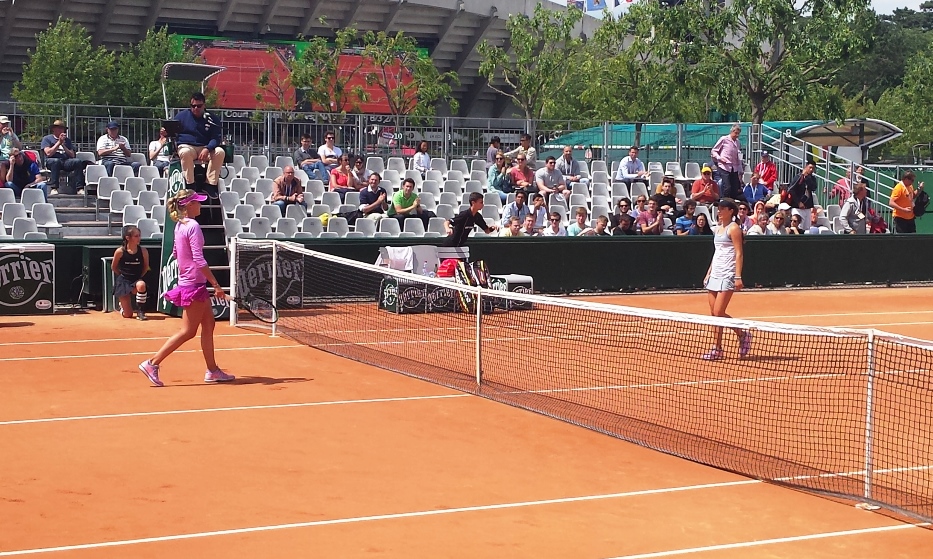
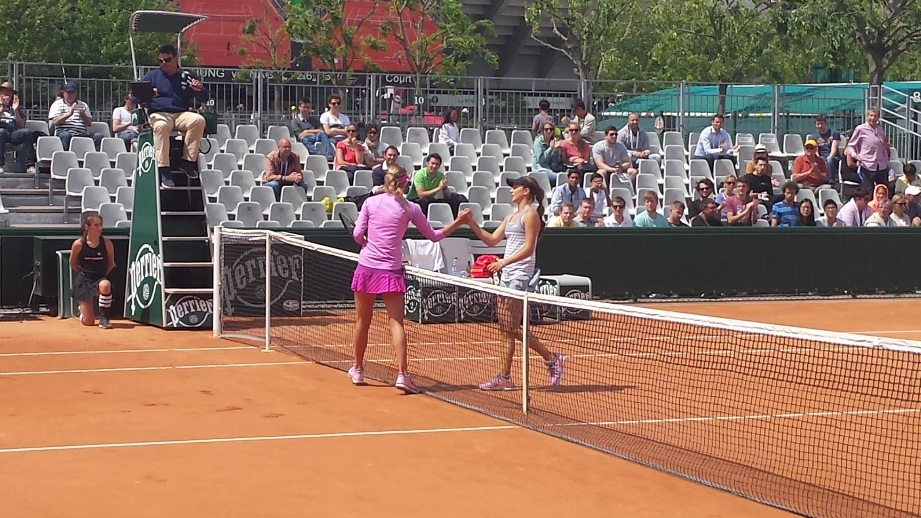
It is one thing to feel the joy of winning a match when one “zones” so to speak. It is another thing to win a match through sheer drive and grit while having to play nothing less than a chess match in the I.Q. department with your opponent.
These two girls, aged 15 and 16, deserve high praise, for sending the message that mentally they are ready to do battle at any level. Just give them a few years to develop their games, get physically stronger, and they will have many more duels to come. On this particular Tuesday, Bellis may have outwitted (and “outgritted”) Zhuk, but their on-court awareness and I.Q., along with their athleticism, makes both of these teenagers compelling prospects for the future of women’s tennis.
Note: Follow Mertov’s Tennis Desk on Twitter for frequent live updates from Roland Garros
Note 2: Thanks to John T. for the clips and the picture during the injury time-out